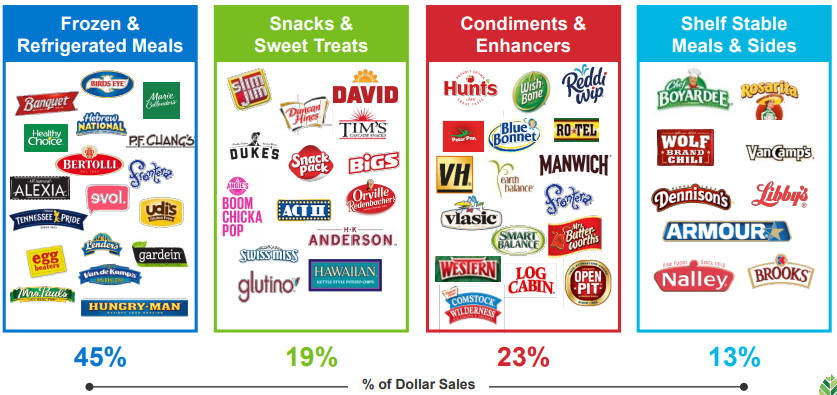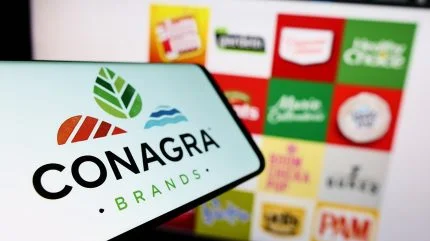Conagra Brands, Inc. is a leading American packaged foods company with a history that spans more than a century. Founded in 1919 as Nebraska Consolidated Mills, the company originally focused on grain milling in the Midwest. Over the years, Conagra evolved into one of the largest and most diversified food companies in the U.S., with a portfolio of iconic brands that can be found in virtually every aisle of the grocery store. The company rebranded as ConAgra Foods in 1971 before adopting its current name, Conagra Brands, Inc., in 2016 to reflect its transformation from a commodities-based business into a consumer-focused packaged foods powerhouse.
Conagra operates through two primary segments: grocery & snacks and frozen & refrigerated foods. Its extensive portfolio includes well-known brands such as Healthy Choice, Marie Callender’s, Banquet, Hunt’s, Orville Redenbacher’s, Slim Jim, and Reddi-wip. These brands cover a wide range of food categories, including frozen meals, snacks, condiments, and shelf-stable goods, providing consumers with a variety of options that cater to different tastes, dietary needs, and occasions.

Conagra’s growth strategy has been centered on three key pillars: innovation, acquisitions, and brand revitalization. The company has focused heavily on modernizing its brands to meet changing consumer preferences, particularly the growing demand for healthier, more convenient, and more sustainable food options. This includes the development of new products that cater to consumers’ desire for plant-based, organic, and clean-label foods. One of Conagra’s major strategic moves was its acquisition of Pinnacle Foods in 2018, which significantly expanded its portfolio of frozen and shelf-stable brands, including Birds Eye, Duncan Hines, and Earth Balance. This $10.9 billion deal positioned Conagra as a leader in the growing frozen foods category, a segment that has seen renewed interest as consumers seek convenient meal solutions.
Innovation is at the heart of Conagra’s success, and the company consistently works to stay ahead of consumer trends. Conagra has adopted a forward-looking approach to product development, with an emphasis on food innovation and leveraging technology to enhance production and meet the demands of a rapidly changing market. For example, it has introduced products that cater to the growing plant-based and gluten-free markets, while also responding to increasing interest in sustainability and responsible sourcing. Additionally, the company has been investing in e-commerce capabilities to adapt to the shift toward online grocery shopping, a trend that was further accelerated by the COVID-19 pandemic.
Sustainability is also a key focus for Conagra Brands. The company has set ambitious goals around reducing its environmental footprint, including a commitment to reducing greenhouse gas emissions, water use, and waste in its operations. Conagra is also dedicated to sustainable sourcing and packaging innovations, ensuring that many of its products are produced with environmentally responsible practices. For example, it has pledged to make 100% of its packaging recyclable, compostable, or reusable by 2025, part of its broader effort to reduce plastic waste.
Leadership and culture at Conagra reflect the company’s values of integrity, teamwork, and continuous improvement. Under the guidance of CEO Sean Connolly, who has led the company since 2015, Conagra has undergone significant transformation, focusing on consumer-driven innovation and operational efficiency. Connolly has been instrumental in steering Conagra towards more agile, consumer-focused operations, leading to stronger brand performance and profitability.

In summary, Conagra Brands stands as a powerhouse in the packaged foods industry, offering a diverse array of beloved brands that meet the evolving needs of modern consumers. With its focus on innovation, acquisitions, sustainability, and adaptation to market trends, Conagra is well-positioned to continue its legacy of growth and success in the highly competitive food industry. The company’s ability to balance heritage brands with modern consumer preferences while maintaining a strong commitment to environmental and social responsibility highlights its continued relevance and resilience in a dynamic market.
Marketing Strategies of Conagra
Conagra Brands has developed robust and diverse marketing strategies to maintain its position in the highly competitive food industry. With a portfolio of well-known brands such as Healthy Choice, Slim Jim, Orville Redenbacher’s, and Hunt’s, Conagra uses a mix of traditional and digital marketing strategies to drive consumer engagement, brand loyalty, and market growth. Let’s explore the key marketing strategies of Conagra in detail:
1. Portfolio Diversification and Brand Revitalization
Conagra has effectively utilized portfolio diversification and brand revitalization as key marketing strategies to adapt to changing consumer preferences and enhance its market presence. By expanding its product offerings beyond traditional frozen meals, Conagra has embraced a range of categories, including snacks and health-focused options. A notable example is the revitalization of the Healthy Choice brand, which introduced new all-natural entrees featuring contemporary recipes like Pumpkin Squash Ravioli and Mediterranean Pasta. This shift not only modernizes the brand but also appeals to health-conscious consumers, positioning Healthy Choice as a leader in the nutritious meal segment while capturing a broader audience.
In addition to product innovation, Conagra has implemented strategic partnerships to enhance brand relevance and visibility. The collaboration with Dolly Parton for the Duncan Hines brand exemplifies this approach, where limited-edition baking kits were created to tap into cultural trends and leverage Parton’s influence. This campaign not only generated significant buzz—selling out in just seven minutes—but also fostered a sense of community among baking enthusiasts. By aligning with popular figures, Conagra revitalizes its brands and engages new consumers, demonstrating how effective partnerships can drive growth and brand loyalty.
Furthermore, Conagra’s focus on brand revitalization extends to its overall business strategy, emphasizing a shift from volume-driven sales to value creation. The company has committed to improving product quality and packaging across its portfolio, as seen with the transformation of the Banquet brand. This initiative aims to elevate Banquet from its long-standing $1 price point by enhancing its offerings and supporting them with targeted advertising rather than relying solely on promotions. By prioritizing quality over price, Conagra not only modernizes its brands but also positions itself for sustainable growth in a competitive marketplace, ensuring that each brand resonates with contemporary consumer values.
2. Emphasis on Innovation and Product Development
Conagra has made innovation and product development a cornerstone of its marketing strategy, allowing the company to adapt to evolving consumer preferences and stay competitive in the food industry. The company has recently launched a variety of new products, particularly in the plant-based segment, such as the Gardein Supreme Black Bean and Falafel burgers. This move responds to the growing demand for healthier, plant-based options among flexitarian consumers. By prioritizing innovation in categories that are gaining traction, Conagra not only expands its product portfolio but also positions itself as a leader in meeting contemporary dietary trends.
In addition to expanding its product offerings, Conagra has focused on revitalizing its iconic brands through modern attributes and consumer insights. The Duncan Hines brand serves as a prime example of this strategy. Conagra has updated existing cake mixes and introduced premium products like the Epic baking kits, which cater to current baking trends while addressing common consumer challenges highlighted by social media discussions around baking failures. This focus on premiumization has allowed Duncan Hines to break free from its traditional price point, significantly increasing sales and fostering a community of engaged bakers eager for new experiences.
Furthermore, Conagra leverages advanced analytics and a demand science group to inform its product development processes. This group gathers extensive data on food trends and consumer preferences, enabling Conagra to identify growth opportunities effectively. For instance, the company has successfully revamped its frozen meal offerings with products like Birds Eye Fusions, which combine elevated vegetables with gourmet sauces. By continuously studying market trends and consumer behaviors, Conagra ensures that its innovations remain relevant and appealing, ultimately driving sustained growth in an increasingly competitive landscape.
3. Strategic Acquisitions and Partnerships
Conagra has strategically employed acquisitions and partnerships as a key marketing strategy to enhance its brand portfolio and market reach. A significant milestone in this approach was the acquisition of Pinnacle Foods in 2018 for approximately $10.9 billion. This acquisition added iconic brands such as Birds Eye, Duncan Hines, and Earth Balance to Conagra’s existing portfolio, allowing the company to expand its presence in the frozen foods and snacks categories. By integrating these complementary brands, Conagra not only diversified its product offerings but also positioned itself to capitalize on the growing demand for convenient and nutritious meal options, driving profitable growth and shareholder value.
In addition to large-scale acquisitions, Conagra has also focused on strategic partnerships to enhance its innovation capabilities. For instance, the collaboration with Dolly Parton for the Duncan Hines brand resulted in limited-edition baking kits that celebrated both baking culture and Parton’s influence. This partnership not only generated significant media attention but also connected with consumers on an emotional level, reinforcing brand loyalty. By leveraging partnerships with well-known figures, Conagra effectively revitalizes its brands and engages new audiences, demonstrating how strategic alliances can drive growth and enhance brand visibility.
Moreover, Conagra’s emphasis on modernizing acquisitions reflects its commitment to adapting to changing consumer preferences. The company has expressed interest in acquiring brands that align with current food trends, such as plant-based products or healthier options. This proactive approach allows Conagra to stay ahead of market demands while ensuring that new acquisitions fit seamlessly into its overall strategy. By focusing on synergistic acquisitions, Conagra not only enhances its scale but also strengthens its ability to innovate and respond to consumer needs effectively, positioning itself as a leader in the competitive packaged foods industry.
4. Health and Wellness Positioning
Conagra has strategically positioned health and wellness as a central theme in its marketing strategy, responding to the growing consumer demand for nutritious and convenient food options. The company has committed to developing products that align with various dietary preferences, such as keto, vegan, and heart-healthy diets. For instance, the Healthy Choice brand features meals that meet the FDA’s definition of “healthy,” offering lower carbohydrate and gluten-free options. By focusing on nutrient-rich offerings, Conagra not only addresses consumer health concerns but also enhances its brand reputation as a provider of wholesome food choices.
In addition to product development, Conagra actively engages in community initiatives that promote health and nutrition. The Conagra Brands Foundation supports programs like the Health and Leadership Program at Erie House, which provides nutrition education and resources to families in underserved communities. This initiative aims to combat issues like diabetes and obesity by equipping participants with essential cooking skills and nutritional knowledge. By investing in community health initiatives, Conagra reinforces its commitment to improving public health while simultaneously enhancing its brand image as a socially responsible organization.
5. Digital Marketing and Social Media Engagement
Conagra has strategically embraced digital marketing and social media engagement as vital components of its marketing strategy, enabling the company to connect with consumers in an increasingly digital world. By leveraging advanced analytics and targeted advertising, Conagra has improved its campaign performance significantly. For example, through collaboration with comScore, the company refined its online advertising approach, achieving a 70% lift in attribute awareness and a 30% increase in purchase intent. This transformation involved negotiating for guaranteed viewability and audience delivery rates, ensuring that ads reached the intended demographic effectively. By prioritizing data-driven decision-making, Conagra enhances its ability to engage consumers meaningfully and drive sales.
In addition to targeted advertising, Conagra has effectively utilized social media platforms to foster community engagement and brand loyalty. The Duncan Hines brand, for instance, has successfully tapped into the baking community through social media campaigns that encourage user-generated content. Initiatives like the “Dolly Drop” limited-edition baking kits not only generated buzz but also created a sense of belonging among consumers who participated in the campaign. The kits sold out within minutes, demonstrating the power of influencer collaborations and social media engagement. By creating interactive experiences, Conagra effectively builds a vibrant online community that resonates with modern consumers.
Moreover, Conagra has invested in innovative digital tools to enhance its marketing efforts further. The company’s partnership with Microsoft and Ernst & Young aims to integrate artificial intelligence into its marketing strategies, allowing for more personalized content creation and improved consumer insights. This initiative focuses on developing branded imagery tailored to specific audience segments, streamlining the content creation process while maintaining high-quality standards. By harnessing emerging technologies, Conagra not only enhances its operational efficiency but also positions itself at the forefront of digital marketing innovation, ensuring that it remains responsive to consumer trends and preferences in a competitive market.
6. Sustainability and Corporate Social Responsibility (CSR)
Conagra has strategically positioned sustainability and corporate social responsibility (CSR) at the forefront of its marketing strategy, recognizing the increasing consumer demand for environmentally friendly and socially responsible practices. The company’s “Good Food” initiative emphasizes the importance of providing safe and nutritious food options while actively engaging in responsible sourcing and sustainable practices. For instance, Conagra has reported that approximately 93% of its packaging materials are renewable, recyclable, or compostable, with a goal of achieving 100% by 2025. This commitment not only enhances brand image but also aligns with consumer values, making sustainability a core aspect of Conagra’s identity.
In addition to packaging initiatives, Conagra actively participates in community support and nutrition programs that reflect its CSR values. The company has partnered with organizations such as United Way and various food banks to provide resources and support to underserved communities. For example, Conagra’s efforts to add over 350 stock-keeping units (SKUs) to WIC-approved product lists ensure that families have access to nutritious food options. By focusing on community engagement, Conagra reinforces its commitment to social responsibility while also enhancing its reputation as a brand that genuinely cares about the well-being of the communities it serves.
7. Data-Driven Marketing and Consumer Insights
Conagra has effectively harnessed data-driven marketing and consumer insights as a key strategy to enhance its decision-making processes and improve engagement with consumers. The company collaborates with analytics firms like comScore to refine its online advertising efforts, which has resulted in significant improvements in campaign performance. For instance, Conagra achieved a 70% lift in attribute awareness and a 30% increase in purchase intent by optimizing its targeting strategies and ensuring that ads reached the right audience. This data-centric approach not only boosts ROI but also allows Conagra to tailor its messaging more effectively, ensuring that it resonates with specific consumer segments.
In addition to refining its advertising strategies, Conagra has invested in advanced analytics tools to gain deeper insights into consumer behavior and preferences. The establishment of a demand science group enables the company to analyze vast data pools and identify emerging trends within the food industry. This quantitative approach has driven successful product innovations, such as the launch of Birds Eye Fusions, which combines elevated vegetables with gourmet sauces. By integrating consumer insights into product development, Conagra ensures that its offerings align with current market demands, thereby enhancing brand relevance and fostering consumer loyalty. This commitment to leveraging data not only strengthens Conagra’s market position but also empowers the company to remain agile in an ever-changing landscape.
8. In-Store Marketing and Promotions
Conagra has effectively utilized in-store marketing and promotions as a crucial strategy to enhance brand visibility and drive sales across its diverse product portfolio. A prime example is the recent campaign that combined three of its brands—Duncan Hines, Gardein, and Swanson—for a spring promotion designed around easy meal preparation during holiday occasions. This initiative featured key stock-keeping units (SKUs) prominently displayed in stores, allowing consumers to see meal solutions that cater to family gatherings and celebrations. By creating a cohesive shopping experience, Conagra not only simplifies the decision-making process for consumers but also boosts sales during peak shopping periods like Easter.
In addition to seasonal promotions, Conagra employs various in-store tactics such as end-cap displays, in-store blades, and recipe integration to engage shoppers at the point of purchase. For instance, the inclusion of Pam cooking spray in end-cap displays alongside meal kits emphasizes convenience and encourages cross-promotion among products. This strategic placement not only highlights complementary items but also drives impulse purchases by showcasing complete meal solutions. By leveraging effective merchandising techniques, Conagra enhances the shopping experience while maximizing product exposure in a competitive retail environment.
Furthermore, Conagra’s focus on digital integration within its in-store marketing efforts reflects its commitment to modernizing consumer engagement. The company has partnered with platforms like AllRecipes.com to create keyword-targeted ads that align with in-store promotions. These digital touchpoints guide consumers to recipes that utilize Conagra products, reinforcing the connection between online engagement and in-store purchasing decisions. By bridging the gap between digital and physical shopping experiences, Conagra not only increases brand relevance but also fosters loyalty among consumers who seek convenient and delicious meal solutions.


